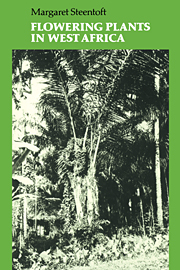Book contents
- Frontmatter
- Contents
- Introduction
- List of symbols and abbreviations
- 1 Species associations
- 2 Vegetation in West Africa
- 3 Annonaceae – soursop family
- 4 Amaranthaceae – amaranth family
- 5 Cucurbitaceae – gourd family
- 6 Ochnaceae – ironwood family
- 7 Combretaceae – afara family
- 8 Guttiferae (Clusiaceae) – butter tree family
- 9 Sterculiaceae – cocoa family
- 10 Bombacaceae – silk cotton family
- 11 Malvaceae – cotton family
- 12 Euphorbiaceae – cassava family
- 13 Caesalpiniaceae – pride of Barbados family
- 14 Mimosaceae – Acacia family
- 15 Papilionaceae – cowpea family
- 16 Ulmaceae – afefe family
- 17 Moraceae – mulberry family
- 18 Meliaceae – mahogany family
- 19 Sapindaceae – akee apple family
- 20 Anacardiaceae – cashew nut family
- 21 Sapotaceae – sheabutternut family
- 22 Apocynaceae – frangipani family
- 23 Asclepiadaceae – blood flower or milkweed family
- 24 Rubiaceae – abura family
- 25 Compositae (Asteraceae) – Tridax family
- 26 Solanaceae – tomato family
- 27 Convolvulaceae – sweet potato family
- 28 Bignoniaceae – jacaranda family
- 29 Acanthaceae – Thunbergia family
- 30 Verbenaceae – teak family
- 31 Labiatae (Lamiaceae) – Hausa potato family
- 32 Commelinaceae – day flower family
- 33 Zingiberaceae – ginger family
- 34 Marantaceae – (West Indian) arrowroot family
- 35 Liliaceae – lily family
- 36 Araceae – cocoyam family
- 37 Palmae (Arecaceae) – palm family
- 38 Orchidaceae – orchid family
- 39 Cyperaceae – sedge family
- 40 Gramineae (Poaceae) – grass family
- General bibliography
- Index of family, generic and common names
30 - Verbenaceae – teak family
Published online by Cambridge University Press: 02 November 2009
- Frontmatter
- Contents
- Introduction
- List of symbols and abbreviations
- 1 Species associations
- 2 Vegetation in West Africa
- 3 Annonaceae – soursop family
- 4 Amaranthaceae – amaranth family
- 5 Cucurbitaceae – gourd family
- 6 Ochnaceae – ironwood family
- 7 Combretaceae – afara family
- 8 Guttiferae (Clusiaceae) – butter tree family
- 9 Sterculiaceae – cocoa family
- 10 Bombacaceae – silk cotton family
- 11 Malvaceae – cotton family
- 12 Euphorbiaceae – cassava family
- 13 Caesalpiniaceae – pride of Barbados family
- 14 Mimosaceae – Acacia family
- 15 Papilionaceae – cowpea family
- 16 Ulmaceae – afefe family
- 17 Moraceae – mulberry family
- 18 Meliaceae – mahogany family
- 19 Sapindaceae – akee apple family
- 20 Anacardiaceae – cashew nut family
- 21 Sapotaceae – sheabutternut family
- 22 Apocynaceae – frangipani family
- 23 Asclepiadaceae – blood flower or milkweed family
- 24 Rubiaceae – abura family
- 25 Compositae (Asteraceae) – Tridax family
- 26 Solanaceae – tomato family
- 27 Convolvulaceae – sweet potato family
- 28 Bignoniaceae – jacaranda family
- 29 Acanthaceae – Thunbergia family
- 30 Verbenaceae – teak family
- 31 Labiatae (Lamiaceae) – Hausa potato family
- 32 Commelinaceae – day flower family
- 33 Zingiberaceae – ginger family
- 34 Marantaceae – (West Indian) arrowroot family
- 35 Liliaceae – lily family
- 36 Araceae – cocoyam family
- 37 Palmae (Arecaceae) – palm family
- 38 Orchidaceae – orchid family
- 39 Cyperaceae – sedge family
- 40 Gramineae (Poaceae) – grass family
- General bibliography
- Index of family, generic and common names
Summary
A mainly tropical and subtropical family of varied habit, though all with opposite or whorled, exstipulate and sometimes fragrant leaves, often on four-angled stems. Ptyxis is conduplicate as a rule, conduplicate-plicate in Tectona. The inflorescences are racemose (less often cymose – Clerodendrum, Premna, and Vitex), but often congested, and made up of small five-part flowers with a two-lipped corolla, four stamens and a two- to eight-celled ovary with a terminal style. The fruit is a drupe, or a schizocarp splitting into four nutlets.
Several ornamental species have been introduced from tropical America, e.g. Petrea volubilis, a climber in which the persistent blue calyx lobes act like helicopter rotors in dispersing the fruit. Duranta repens (now D. erecta: Bromley, 1984), a shrub commonly planted as a hedge, has tubular blue flowers and yellow ‘drupes’. Lantana camara (wild sage or curse of Barbados) has short spikes of yellow or reddish flowers and does not set fruit in West Africa. In the West Indies it is probably pollinated by butterflies.
From tropical Asia, Gmelina arborea, with large flowers suitable for investigation, and Tectona grandis have been introduced as plantation trees, while Holmskioldia sanguinea (Chinaman's hat) and Clerodendrum spp., e.g. C. fragrans (now C. philippinum; Howard & Powell, 1968), are ornamentals.
Black mangrove (Avicennia Africana) is now placed in its own family Avicenniaceae, Congea tomentosa (with three large persistent bracts and bracteoles per flower) in Symphoremataceae. The former family is monogeneric, the latter trigeneric, both with free central placentation.
- Type
- Chapter
- Information
- Flowering Plants in West Africa , pp. 252 - 257Publisher: Cambridge University PressPrint publication year: 1988



